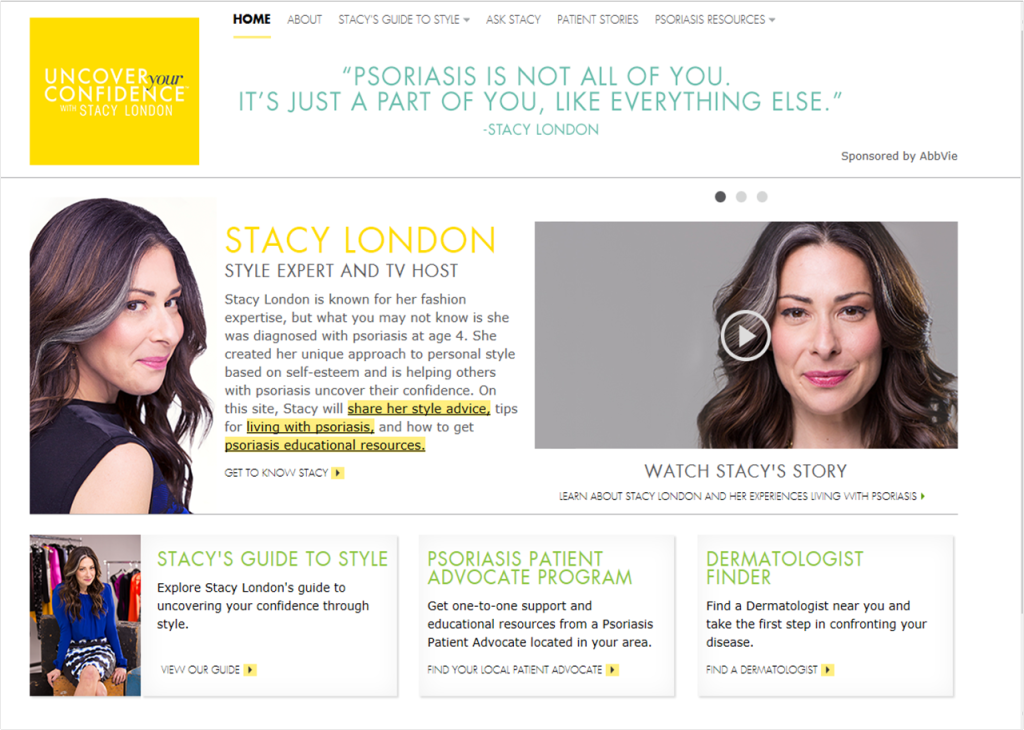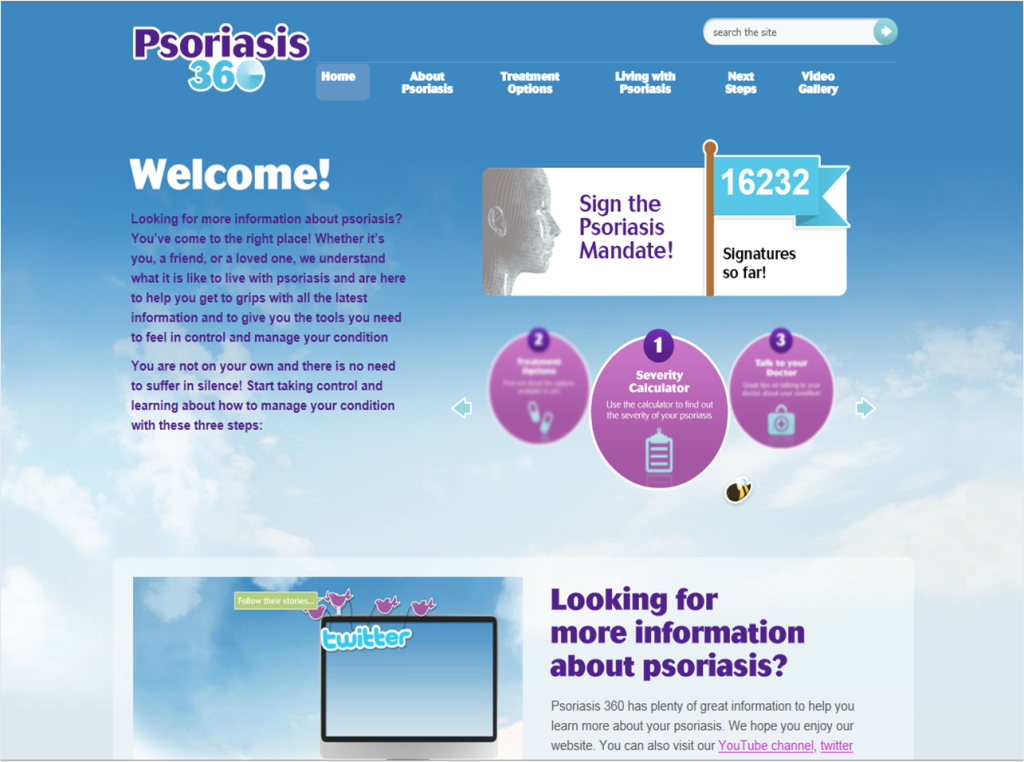Manhattan Research’s ePharma Consumer 2012 study reported that just under one-third of online consumers visit pharmaceutical product websites for health information and just over one-quarter visit pharma corporate websites for health info. Moreover, just under one-fifth of online consumers reported visiting a pharma-sponsored condition or disease website.
Cutting Edge Information’s Patient Adherence and Compliance Study, found that when targeting patient adherence, pharma companies consider creating customized information for patients to be among the leading challenges they face. The study concluded that effectively disseminating information and providing value to patients starts with adopting a patient-centric approach and understanding their concerns.
So what actions can pharma take to improve on their efforts to increase patient adherence? Prill Nugent, Creative Director of Topin Associates, Inc., a healthcare communications agency, shares her perspectives on two unbranded psoriasis sites, AbbVie’s “Uncover Your Confidence” and Janssen’s “Psoriasis 360,” including how these sites provide value and if they are effective in helping adherence. Healthcare research experts, Matthew Arnold, Principal Analyst, Manhattan Research and Sarah Ray, Research Analyst, Cutting Edge Information also weigh in how pharme can improve its online presence.
AbbVie’s Uncover Your Confidence: http://uncoveryourconfidence.com
The “Uncover Your Confidence” website is a new destination for people with psoriasis to find resources that will help them confidently confront their disease. It also provides access to the Psoriasis Patient Advocate Program which pairs those with psoriasis with trained professionals in their local area who can provide one-to-one support, education and resources.
What resources and benefits does the site provide that patients want?
Prill Nugent: Psoriasis is a challenging, chronic, lifelong condition with no cure but with many options for treatment. The effectiveness of treatments depends to a large extent on the ability of the patient to proactively manage over-the-counter and, with a trusted dermatologist, prescription medications until the right one or combination is found. Fashion consultant and TV host Stacy London says in her featured section of Uncover Your Confidence, “the worse you feel, the more you have to do.”
For the psoriasis patient who is feeling bad but doing more, Uncover Your Confidence offers them plenty of encouragement, information and opportunities to connect. A Facebook page offers community, and the Psoriasis Patient Advocate Program offers one-on-one support by trained professionals via e-mail, phone or in person.
The site is well organized and the navigation is intuitive, making it easy for patients to find what they want quickly and easily. The tone, starting with the site’s name, is optimistic and focused on the positive. By partnering with Stacy London, the site welcomes patients into a world in which they are not defined, or defeated, by their disease.
What does the site lack or what areas can they do better in?
As patient centered as the site is, there are a couple of issues that take away from its overall effectiveness. The first is the depth of information about treatments. While there is a header for treatments, the content simply identifies the types of treatment and directs the patient to his or her dermatologist. The second issue is that there are no interactive tools or activities that require ongoing interaction. In this way the site has lost an opportunity to bring people back or support increased adherence.
Janssen’s Psoriasis 360: http://www.psoriasis360.com
Janssen’s Psoriasis 360 is a digital tool that provides those who live with psoriasis with all the latest information and tools they need to feel in control and manage their condition.
What resources and benefits does the site provide that patients want?
Prill Nugent: Psoriasis 360 is a digital presence that includes YouTube videos and a Twitter feed in addition to the standard web content on the site. Apps for iPhone and a computer screen are also available. (The company recently dismantled its Facebook page citing regulatory and conduct issues). Strong points of the site include a comprehensive interactive tool to prepare for a doctor’s visit and treatment information linked to the severity of the psoriasis. A great deal of information is provided about psoriasis and how to manage it. Downloadable patient tools summarize information provided on the site for lifestyle modifications.
What does the site lack or what areas can they do better in?
This is clearly a European site and, according to a footnote on the home page, it is intended for a European audience. All doctors in videos speak with European accents, and a number of idioms are used in less than flowing prose. Upon entering the site, the visitor is invited to sign a mandate that relates to European psoriasis patients. Not that there’s anything wrong with a European site; it could just be more welcoming were the text personalized to each market it appears in.
A variety of technical issues could be modified for a better patient experience. Links to references do not go to the correct citation, a video does not load, and many interactive graphics do not move smoothly. Then there’s the bee. An animated bee flies around in seemingly random motion, not doing much more than annoying the viewer.
Tips For A Better Online Presence
Panorama also asked our experts: What do patients generally want from pharma online services, and how can pharma provide value to them and increase adherence? In total, they provided six tips to improving pharma’s online presence.
1. Quality Information and Better Online Resources
Prill Nugent: Interest in online pharma is strong. Patients appreciate quality information and help managing chronic diseases. Uncover Your Confidence’s upbeat tone and proactive stance provides the visitor a positive, supportive experience. Other resources patients want, such as financial assistance and access to registered nurses, are provided on the Humira branded website.
Patients have indicated when surveyed that they would like pharma to help them manage a chronic disease and they would register for a patient support program that offered various resources. The branded Stelara site (www.stelarainfo.com) offers a savings card, information on financial aid, and a program for patients that includes an eBook, reminders, and other support. When evaluating non-branded pharma sites, it is often necessary to review the corresponding branded product site as well to determine the extent of resources offered.
Sarah Ray: Because patients turn to websites as a preliminary treatment measure, patients [and companies] can benefit from better online tools.
Several companies have designed short quizzes or questionnaires to connect with patients who either have a specific disease or who feel they may be at risk, and to encourage patients to consult with their physicians for more information. For example, on its Drive4COPD Initiative website, Boehringer Ingelheim offers patients a brief questionnaire to assess their probable risk of COPD. At the end of the assessment, Boehringer encourages individuals who receive a score higher than five to follow up with a physician.
Creating accessible online resources and promoting them to target audiences will continue to help companies provide value to patients by making them active participants in their own treatments.
2. Better Website Design
Matthew Arnold: We’re seeing change happening in how pharma companies are building and designing their websites. A number of pharma companies are rethinking what they do on the web. They’re motivated in some cases by competitive factors and in others by a post-ACA shift towards outcomes-oriented support tools, but across the board, the influence of mobile optimization and responsive design are plain
3. Investing More Into Digital
Matthew Arnold: Reach is still an issue for pharma sites. General consumer health sites such as WebMD and Everyday Health have a much greater reach among consumers looking for prescription drug information and resources than do pharma sites, and they lead many more of those consumers to discuss a specific prescription drug with a healthcare professional. That’s not to say pharma sites aren’t effective. In fact, we found that online resources from pharma sites have an outsized impact on patients’ confidence in their treatment plan—71% of online consumers who have used digital pharma resources agreed that they felt more confident about a prescription after doing so, and 68% of users said they feel more in control of the condition overall. This means heavy investment into their digital resources may be worth it for some companies. However, brands would greatly benefit from a distributed content strategy that gives them visibility on general health sites and drives traffic to their own properties.
4. Medical Jargon-free Websites and Easy Access to Info
Sarah Ray: Companies will benefit from leveraging straightforward platforms, relatively free of medical jargon. Easily accessible information helps patients to pinpoint solutions to their medical concerns without requiring them to navigate through an entire website.
5. Celebrity Spokespeople
Sarah Ray: Companies may also leverage familiar faces who have struggled with a disease. This strategy may provide encouragement for patients, while affirming that they are not alone in managing their treatment course. Famous success stories can inspire patients who may not initially buy into the benefits of undergoing consistent treatment
6. Anticipating Patient Needs
Sarah Ray: Many companies have experienced success relating to patients through unbranded websites such as PatientsLikeMe. Specifically, these websites facilitate patient adherence by promoting preventative, early screening sessions as well as providing ongoing treatment information for diagnosed patients. Appealing to patient audiences will require pharma companies to anticipate patient needs and address them efficiently and explicitly.
Taking patients’ perspectives to heart when designing unbranded webpages helps companies provide value to the patient populations they serve. A patient-centric approach ensures that companies anticipate patient needs—working with them as opposed to talking at them. Many pharma companies have already taken the first step toward providing value by leveraging the power of community to highlight that patients are not alone in managing their disease state.
Pharma may not have all the answers any more than the patients they target. However, a collaborative effort between patients and pharma in which both groups work together to promote disease state awareness is a good start.








